The biggest. The greatest. The best. The Hermitage. You may skip the raising bridges’ show and even the Amber room in Catherine’s palace, but the absence of the Hermitage in your St. Petersburg itinerary will make you come back here since your friends and relatives will hardly understand you if you wouldn’t visit Russian museum the most known abroad and one of the most famous in the world.
UPDATE: the information in the post has been updated in early 2020.
Standing for a minute in front of every item of the Hermitage will take you more than 10 years without eating, drinking, and sleeping. The museum contains 3 100 000 exhibits with almost 17 000 paintings among them. As you will not be able to watch all the items which are worth seeing, read our advice on what to see during your short visit (we mean 3-5 hours, not sure that you’ll endure more).
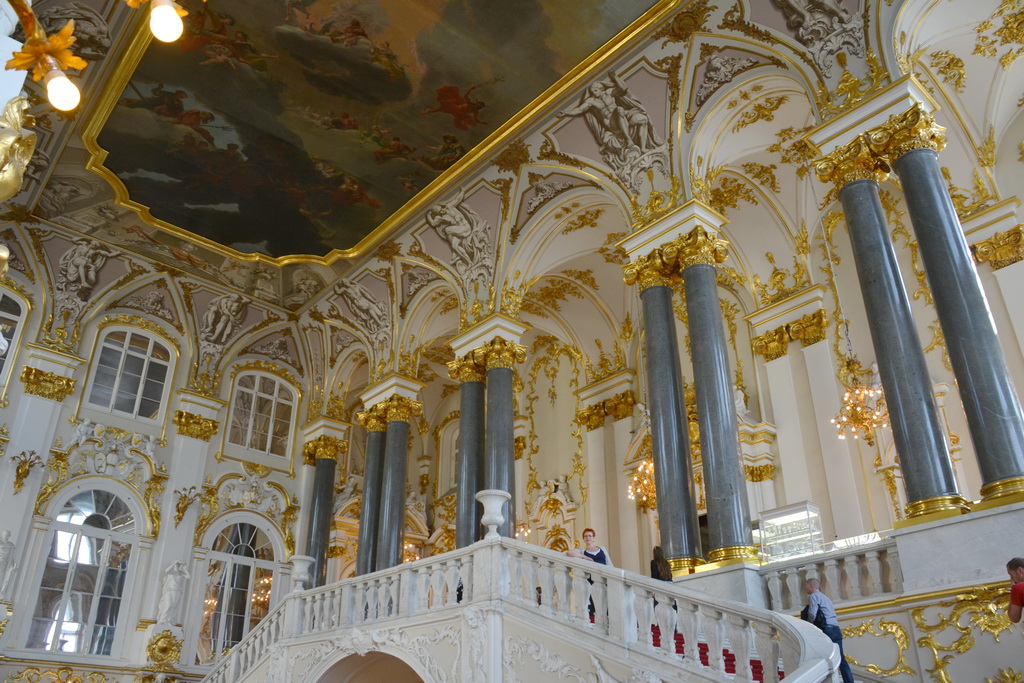
Navigation In This Post:
— Reasons to visit the Hermitage
— Buildings, addresses and opening hours
— Other branches of the Hermitage
— Tickets to the Hermitage and its branches
— Tips and rules for visiting the Hermitage
— How to get to the Hermitage
— The best time for visiting the Hermitage
— What to see at the Hermitage?
— Photo
— The most popular myths about the Hermitage
— Café and souvenirs at the Hermitage
— Cats at the Hermitage
Reasons To Visit The Hermitage
• Really great collection of paintings, antiquities, jewelry, engravings, etc. From ancient Egypt through the Renaissance to modern times.
• Interiors. All the Hermitage buildings were built during the reigns of Russian Emperors with the main building (the cover photo) being the Emperor’s residence with ballrooms, halls, living rooms of the royal family. Not surprisingly, the Hermitage serves as a spot for taking wedding photos.
• Nice photos, selfies with Rafael’s or Michelangelo’s or Claude Monet’s paintings in the back.
• Opportunity to compare the Hermitage with the Louvre in Paris or El Prado in Madrid.
• A good option to spend half a day or a whole day interestingly and efficiently on a rainy day in St. Petersburg.
• It will be difficult to find someone who would believe that you did not visit the Hermitage during your stay in St. Petersburg.
Buildings, Address, Opening Hours 2020
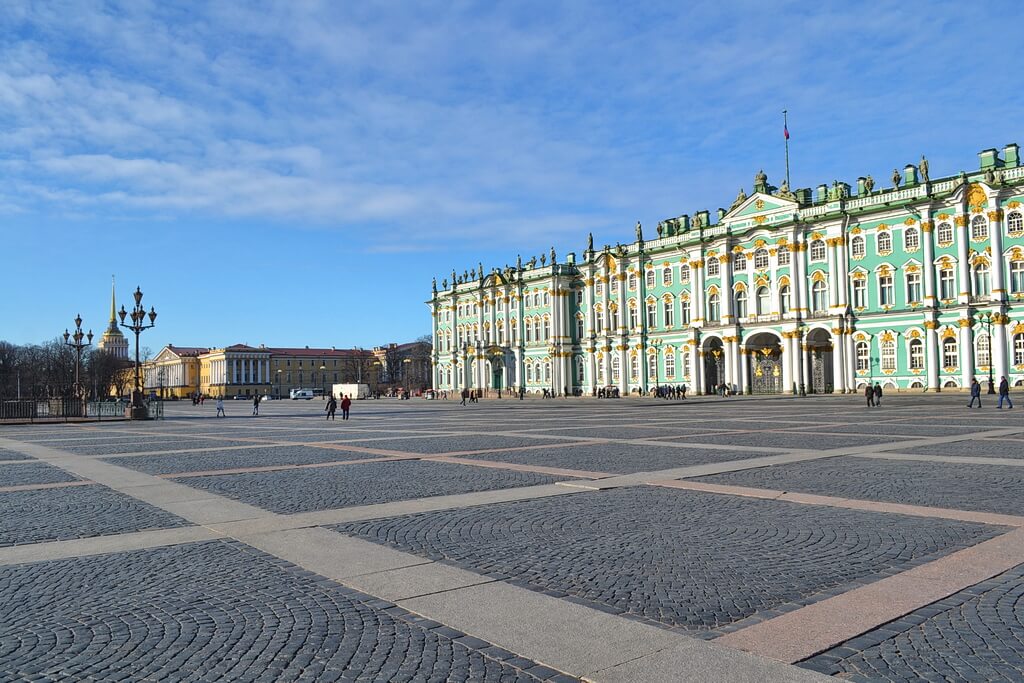
Winter Palace and Palace Square
The core of the collection is located in five connected buildings of a single architecture complex: the Winter Palace, Small Hermitage, Great (Old) Hermitage, the New Hermitage, and the Hermitage Theatre. To be honest, to most of the visitors, including residents of St. Petersburg, it’s one building, most people would struggle to say where the Old Hermitage ends and the New Hermitage begins.
These five buildings are called «main complex» and are referred by locals to as «Winter Palace». This main complex is what you see on typical photos of the Hermitage (including our cover photo) and postcards.
The real address of the main complex: Dvortsovaya (Palace) square, 2, we mean where the main entrance is. To get into the museum you have to pass through the gate on the photo and cross the Great courtyard. The official (legal) address of the museum is 34, Dvortsovaya (Palace) embankment.
Opening hours of the main museum complex, the General Staff, Menshikov Palace, Museum of Imperial porcelain factory:
— 10.30-18.00, on Wednesday and Friday 10.30-21.00;
— Monday, January, 1 and May, 9 are days off;
— on December, 7 and May, 18 and every third Thursday (since 01. 01. 2019) of a month admission is free.
Other Branches Of The Hermitage
The overview above is about five Hermitage buildings comprising one complex that’s located at the Palace square. However, the museum complex is much more than these five buildings. The Hermitage possesses also other branches worth visiting (the full list below).
• General Staff Building
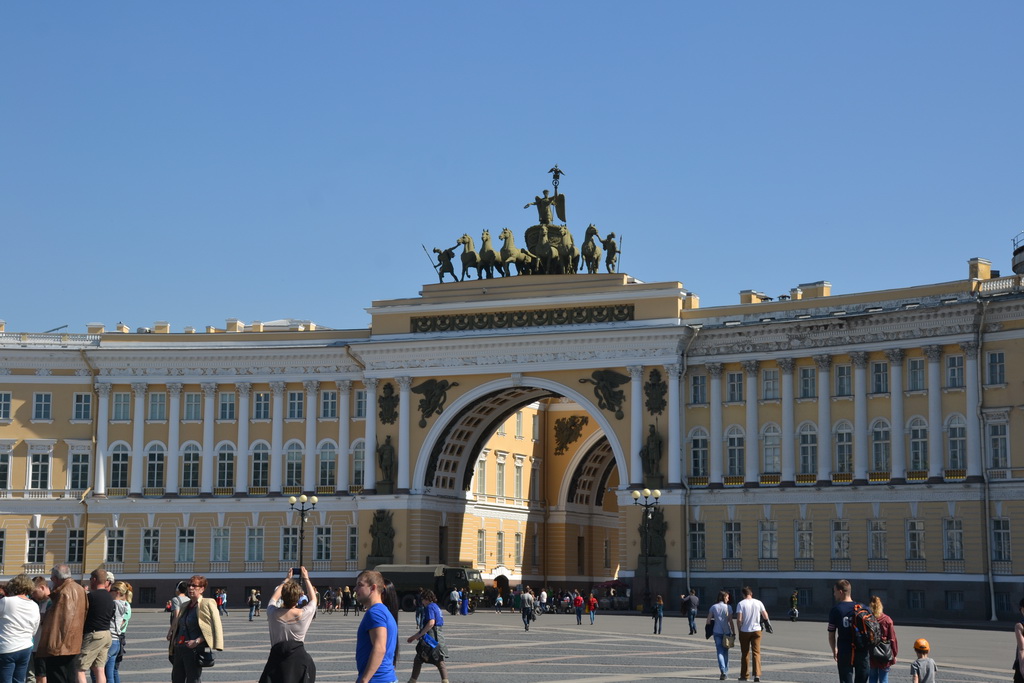
General Staff Building
Just opposite the Winter Palace, across the Palace square stands enormous and very imposing General Staff, a part of which belongs to the Hermitage (see photo below). Now it serves as a constant exhibition, and some temporary exhibitions are being hosted as well. The other part of the building is owned by Russian military forces.
Address: 6/8, Dvortsovaya (Palace) Square
• Menshikov palace
Again opposite the Winter Palace, but this time across the Neva river, is located the Menshikov’s palace that hosts constant exhibition to give you insights of the practicalities of life of early years of St. Petersburg’s history. Alexander Menshikov was the first governor of the city.
Address: Universitetskaya (University) embankment, 15.
• Museum of the Imperial porcelain factory
The Museum of Porcelain in the structure of the Imperial porcelain factory, one of the oldest and most famous companies of St. Petersburg. Exhibition: the history of porcelain.
Address: 151, Obukhovskaya oborona avenue
• The Staraya Derevnya Restoration and Storage Center
The Staraya Devernya (Old Village) restoration and storage center introduces to you the museum’s stocks and the storage conditions. Here you will see paintings, frescoes, furniture, tents, canvas, and coaches.
Address: Zausadebnaya street, 37A, metro station Staraya Derevnya.
Opening hours: Wednesday — Sunday, 11.00, 13.00, 13.30, 15.30. Visits within a guided tour only (550 rubles in 2020, free admission on December, 7 and every first Thursday of a month).
Tickets To The Hermitage And Its Branches 2020
Detailed information on the tickets to the Hermitage is here: http://www.hermitagemuseum.org/wps/portal/hermitage/tickets
You can also purchase a ticket online to avoid queue:
https://www.hermitageshop.org/tickets/
The ticket system of the Hermitage is very simple:
Entry ticket to the Main Museum Complex and the branches (The General Staff building, Menshikov palace, the Museum of the Imperial porcelain factory): 800 rubles.
Entry ticket to one of the Hermitage branches (Menshikov Palace, the Museum of the Imperial Porcelain Factory): 300 rubles.
The third Thursday of each month is a day of free entrance to the museum for all individual visitors (with free tickets). Excursions are paid.
Free entrance independent of nationality:
— preschool children,
— school children,
— students.
Entry ticket + excursion to the Staraya Devernya (Old Village) restoration and storage center: 550 rubles.
Tickets can be bought at four places:
— online (which we recommend as you’ll not be obliged to stay in a long queue);
— at the Main Museum complex (the Winter Palace);
— at the General Staff building;
— at the official hotel of the museum also called The Hermitage (10, Pravda street).
Tips And Rules For Visiting The Hermitage
There are no strict rules for visiting the museum, but some tips we think necessary to share.
• We’d advise you to buy ticket online (https://www.hermitageshop.org/tickets/) or through a vending machine in the courtyard. You might ask why is there such a long queue to the cash-desks if this nice option exists? The reason behind this is that the queue is inhabited by Russian or Belorussian citizens who have a right to buy a ticket at a reduced price (which is impossible online). As you are reading this text, you’re likely to have to buy the ticket at a full price. So do it online and go to the entrance passing by the queue.
• The Hermitage launched a very useful soft «Trip planner», you make up your personal collection and get a route. You can find it here: https://www.hermitagemuseum.org/wps/portal/hermitage/trip-planner-start-view
• It’s strongly advised not to wear shorts and T-shirts not to look like a provincial peasant coming to the Emperor with a petition.
• As well it is highly recommended not to wear shoes with heels as it can damage parquet made of primary timber.
• Don’t touch the exhibits.
• Big bags, backpacks, and suitcases need to be left in the cloakroom.
• No drinking and eating inside the halls and galleries. All the bags are X-rayed when coming in.
• No chewing gums. Unlike in other countries, in Russia it is regarded impolite to chew a gum during a conversation, and when visiting museums, theatres, attending public events.
• There is a free Wi-Fi network at the Hermitage accessible via registration per SMS. This kind of registration is a requirement of the Russian law.
• If you have questions, contact the Visitor’s center: phone: +7 812 710 90 79, e-mail: visitorservices@hermitage.ru
How To Get To The Hermitage
The nearest metro station to the museum is Admiralteyskaya, see the map below (red font). Also, the stations Nevsky prospect and Gostinny dvor are also not far.

A short walk from Admiralteyskaya to Nevsky avenue, a short walk along the Nevsky or the Bolshaya Morskaya (Big Sea street) street, and at the very end of the Nevsky you see the museum.

Tip: when walking along Nevsky avenue you have a very good point for orientation to find the right direction to get to the Hermitage or the Dvortsovaya (Palace) square: the pick of the Admiralty, a naval academy and the Russian navy’s headquarters. The Admiralty is located just across the museum and the square.
The main entrance is from the square, through the gate you can see in the picture below. You have to pass through the gate to find yourself in a courtyard. A long queue is the best indicator where the box offices are.
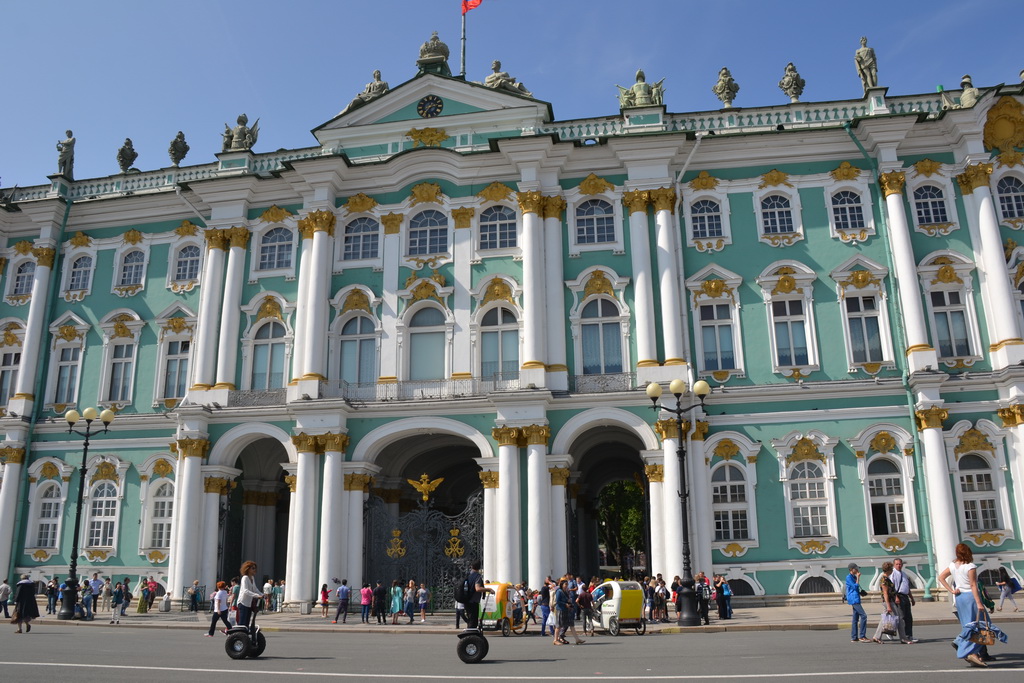
The Best Time For Visiting The Hermitage
The museum is closed on Mondays. On Tuesdays, Thursdays, and Saturdays it is open from 10.30 to 18.00, on Wednesdays and Fridays from 10.30 to 21.00, on Sundays from 10.30 to 18.00. Box offices close an hour before the closure of the museum.
The days-off: Mondays; January, 1 and May, 9.
The Hermitage is unsurprisingly more inhabited on weekends as well as during Russian school holidays: in early January, in late March, in the summer (the longest holidays), in early November. The largest number of visitors is in the summertime when Russians are being added by foreign guests who often come by groups from cruise ships. The halls of Rembrandt and Leonardo are often being overcrowded. And the warmer and more pleasant the weather is, the shorter is the queue for tickets and fewer people use the wardrobe. On a rainy day, the capacity of the wardrobe quickly gets over.
Tip: the flow of visitors is getting smaller at about 4 p. m., two (five on Wednesdays and Fridays) hours before the museum closes. For a rapid overview without profound studying every item two (and all the more five) hours are fairly enough. Or come 15 minutes before the Hermitage opens to find yourself in the queue that usually quickly disappears.
What To See At The Hermitage?

• The Winter Palace, its white marble Jordanian staircase, ceremonial halls on the way to the Throne Hall, the portraits of Russian military commanders of the 1812 Great Patriotic War against Napoleon’s France.
• The painting gallery which contains items of the European painting school from the Middle Ages to the XXth century, including works of da Vinci, Rafael, Titian, El Greco, Rembrandt, Rubens, and many other world-famous artists.

• As a special point to visit we’d recommend the French collection From Monet to Picasso.
• The Knight’s hall (the photo below).
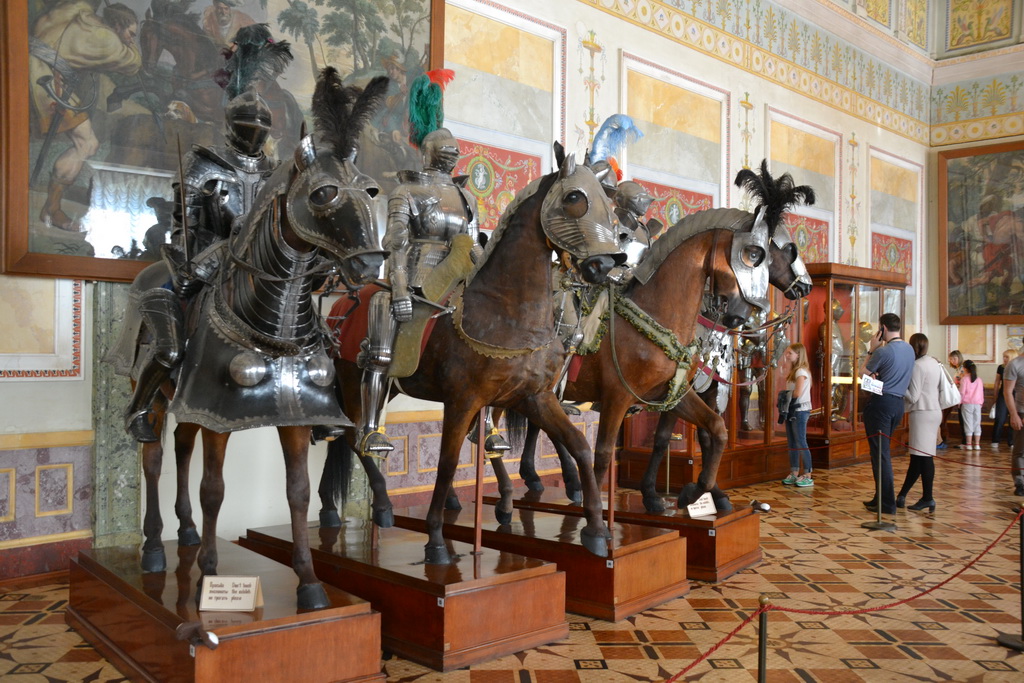
The Knight’s hall
Here are swords, shields, armour suit, helmets, pistols, plumes and arquebuses. Most items are of XV-XVI centuries. The hall is the biggest favorite among kids, it’s difficult to get them out of there, so we’d recommend you to put it at the end of your Hermitage journey.
• The Antique art halls (the photo below) are traditionally packed with statues of Greek and Rome gods, ceramics that keeps the aroma of ancient wines and oils. The ancient times’ theme goes on in the halls of Japan, China, and Egypt with its granitical tomb.
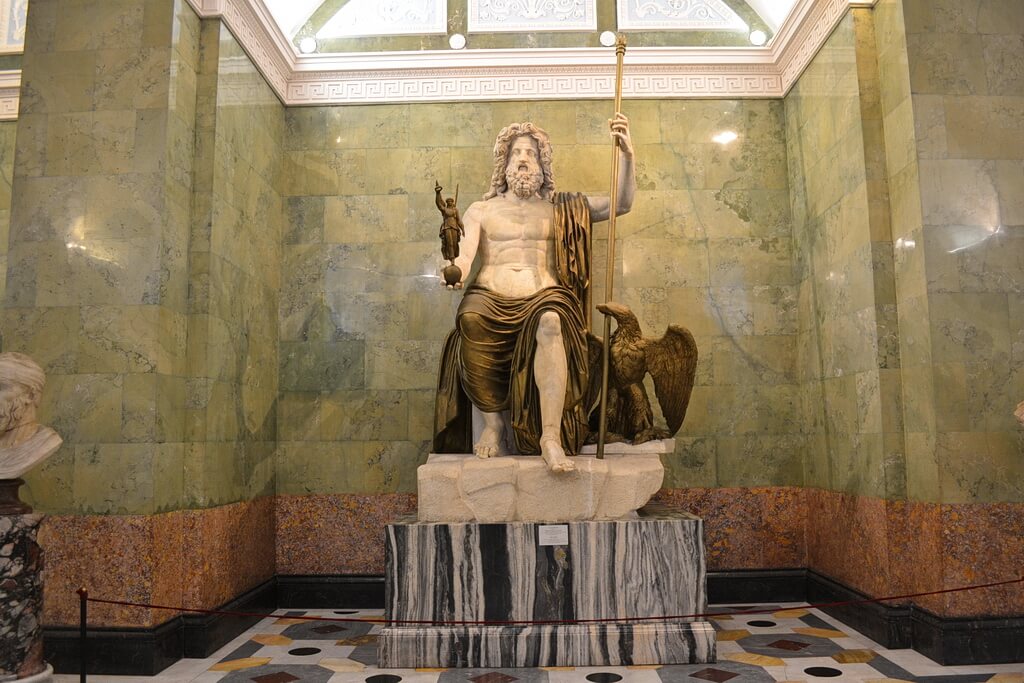
The Antique art halls are traditionally packed with statues of Greek and Rome gods

The Egypt hall
• In the section of Pre-History you will be astonished by the statue of a tattooed chieftain and the biggest felt carpet in the world dated back to the first millennium B.C. with the picture of the chieftain standing before the god.
• The golden and brilliant stockrooms contain gold items extracted from tombs, as well as personal bijouterie of the Romanov ruling family. The access to the stockrooms is through special tickets.
Tip on how to find the halls and orient oneself in the museum: just upon the entrance, before the box offices and inside before the turnstiles there are special leaflets in a few languages with layouts of the Hermitage.
If you don’t want to stroll solo or want to be guided, you can rent an audio guide for 500 rubles (security deposit of 2,000 rubles or any ID except passport) and take a route you like, or buy an overview excursion in a group.
You can rent an audio guide at the:
— Main Gallery. Ground floor, at a desk before turnstiles.
— The upper pace of the Jordanian staircase.
Languages available are Russian, English, French, German, Spanish, Italian, Japan, Chinese and Korean.
You can buy an excursion at a box office or by phone; booking excursions for groups by phone +7 812 571 84 46. For inquiries, contact the Visitor’s centre: phone: +7 812 710 90 79, e-mail: visitorservices@hermitage.ru
For a group of up to 7 persons, an excursion to the Main complex or General Staff on a non-Russian language costs 7,000 rubles.
Taking Pictures

Until recent times, there were strict rules regarding photos in the museum, now they have been softened a bit to put the museum in line with the modern times when everyone can shot a picture with an iPhone or any other small gadget. The rules now say that you can take photos as much as you want and almost everywhere you want, but without using a flash.
Photo and video are prohibited at the temporary exhibitions.
You can also organize an amateur wedding or just a fancy-dress shooting for a group of no more than 5 persons for 5,000 roubles provided you purchase entrance tickets too.
The Most Popular Myths About The Hermitage
You will not see in the Hermitage:
• Mona Lisa. This masterpiece of Leonardo da Vinci is in the Louvre in Paris.
• The Amber Room. It’s located in Catherine’s palace in a town of Pushkin.
• The Emperor’s sleeping room with a bed. The furniture of the royal family’s rooms didn’t survive. The Blue sleeping room now hosts temporary exhibitions.
• The Emperor’s crown. It is in Moscow with the scepter and the ball.
• Faberge’s eggs. They can be found at the Faberge’s museum.
• The coach. The golden coach used to stand at the Feldmarshall’s hall, but now all the coaches are at the museum depository.
• The paintings of Salvador Dali.
Café And Souvenirs At The Hermitage
The café is located on the ground floor. You will not find here hot meals, only drinks, sandwiches, desserts, etc. Not as gorgeous as the Hermitage itself, but rather cozy and with Internet access via laptops or Wi-Fi. The laptops can guide you through the museum’s collections. The prices are in line with eateries in the Nevsky prospect.
Souvenirs from the Hermitage range from traditional magnets and postcards to jewelry, porcelain, reproductions of famous paintings, books about art for kids, bags, wallets, etc.
To buy one Rembrandt? We didn’t ask, but don’t think it is easy, though who knows.
Cats At The Hermitage
Look at the sign below:

It’s not a joke, it’s a real official sing regulating vehicle movements behind the museum’s gate.
The museum’s storage is being guarded by several dozens of cats, which are unfortunately not being allowed to visit the halls and galleries. Though, of course, they penetrate the prohibited areas sometimes:) And often they can be seen near the entrance.